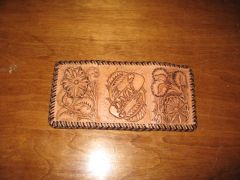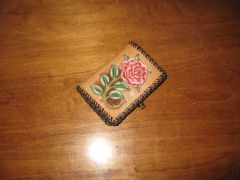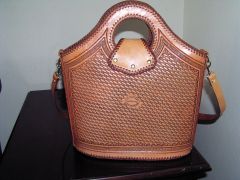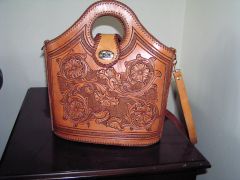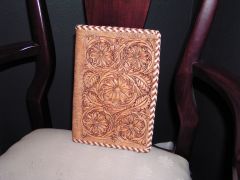-
Posts
47 -
Joined
-
Last visited
About phlegmaticdog
- Birthday July 9
Contact Methods
-
Website URL
http://
Profile Information
-
Gender
Male
-
Location
Lakewood, Colorado
-
Interests
Playing the piano, hiking with my Labrador Retriever Magnus,gardening, photography
LW Info
-
Leatherwork Specialty
wallets, notebooks, belts, dog collars, backpacks,etc.
-
Interested in learning about
everything
phlegmaticdog's Achievements

Member (2/4)
-
As mentioned before by Leatheroo, X-ray film is a great medium for designing and saving patterns. It is strong, yet flexible and easy to cut. Since it's thick plastic it lasts virtually forever. About half of each sheet is transparent which facilitates tracing. Hospital X-ray departments throw away many sheets every day during start-up and calibration of the machines. If you have a friend in the medical field they can make inquiries, If not, a few kind words to an xray technician will enlist him/her to your cause. (you might even make a key fob in exchange and have a friend for life).
-
-

Large Photo Notebook
phlegmaticdog replied to TimKleffner's topic in Books, Journals and Photo Albums
Beautiful work, Tim. Do you buy the ring mechanism separately or tear apart a finished notebook to get it? --Dave -
A friend has requested a couple of lanyards (those straps you've seen people wear around their necks) to hold her ID and credentials. She wants them dyed black. Of course, I don't want the black dye to rub off on her clothing so I need to seal the lanyard and probably waterproof it as well. What finishing product(s) would you guys/gals recommend? She says she also occasionally wraps the lanyard around her credentials to carry in her purse, so the lanyard must be flexible as well. I'm using a light 4/5 leather. Thanks, Dave
-
Nice work Rusty. I really like it Dave
-

recovered kitchen chair
phlegmaticdog replied to flyingcuda's topic in Furniture: Inlays and Upholstery
That's really nice. Are you planning to do a matching set? -

Handbag
phlegmaticdog replied to phlegmaticdog's topic in Purses, Wallets, Belts and Miscellaneous Pocket Items
Thanks for all the nice comments. I used eco-flo saddle tan hi-lite diluted 1:1 with water and gave the leather a heavy coat until it had taken just about all it would absorb (thus no blotches). After it dried, I put on a coat of RTC and finally a coat of Fiebings antique saddle tan. -
-
I agree with Ray. I'd want to keep them on display behind glass for fear of scratching them! Seriously though, these are truly beautiful. Dave M
-

Sword Sheathes
phlegmaticdog replied to zhh660626's topic in Gun Holsters, Rifle Slings and Knife Sheathes
Beautiful work and very unique. Any chance you could show a photo of the carved leather before you wrap it around the template on a future project? Thanks, Dave -

new belts
phlegmaticdog replied to bran7347's topic in Purses, Wallets, Belts and Miscellaneous Pocket Items
Nice work. Good job on the hand stitching! Dave -

Rose coin purse
phlegmaticdog replied to phlegmaticdog's topic in Purses, Wallets, Belts and Miscellaneous Pocket Items
This was Eco-Flo scarlet dye Dave -

Rose coin purse
phlegmaticdog replied to phlegmaticdog's topic in Purses, Wallets, Belts and Miscellaneous Pocket Items
I make 3 or 4 different dilutions of the dye mixed with water; 1:10, 1:5, 1:2, full strength, etc. After dipping the brush in the least intense color (1:10), I brush it onto a paper towel until the brush is almost dry, then use that brush to color the entire rose. Since the brush doesn't have much paint on it, it takes several repetitions to achieve the desired color but by selectively adding layers where you want the color to be most intense--such as at the centers of the rose petals--you have a lot of control over the gradient of color and can get a much more appealing 3D appearance. Then change to the dilution one step higher and repeat the process, but only in the areas where you want more color. Repeat again with the next dilution. Finally you can use undiluted dye in a very few select areas but don't overdo it. In a few areas where I want to give the illusion of reflected light I add a few drops of cova white to the most dilute mixture and --again, using a very dry brush-- touch-up a few spots on the outer edges of the petals. The same process is used on the leaves but I don't use as many different dilutions since there isn't as much detail to complement. This dry-brush method takes some extra time, but the results can be very nice.







